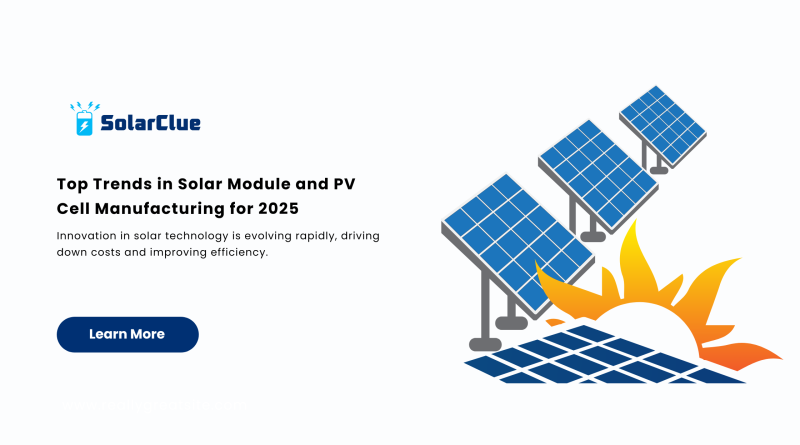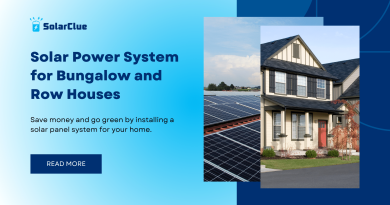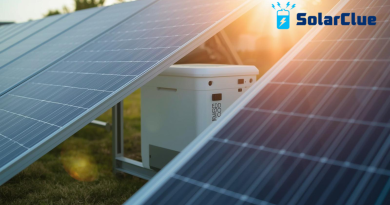Top Trends in Solar Module and PV Cell Manufacturing for 2025
Innovation in solar technology is evolving rapidly, driving down costs and improving efficiency. For example, the average efficiency of commercially available solar panels has increased from around 15% to over 22% in the past decade, while the cost of solar PV systems has dropped by nearly 70% since 2010, according to a report by the International Renewable Energy Agency (IRENA). As the demand for renewable energy surges, solar panels are becoming more accessible for homes and businesses. In this article, we explore the key trends reshaping the solar power system landscape in 2025, including advancements that affect photovoltaic panels price, sustainability, and smart technology integration.
Table of Contents
- 1 Top Trends in Solar Module and PV Cell Manufacturing for 2025
Top Trends in Solar Module and PV Cell Manufacturing for 2025
Advanced Materials for Higher Efficiency
Materials science is at the forefront of improving solar panel efficiency. In 2025, manufacturers are increasingly turning to cutting-edge materials like perovskite and tandem cells, which offer superior light absorption and energy conversion.
Benefits for Solar Systems
1. Higher efficiency translates to lower costs over time.
2. Enhanced performance makes home pv panels more viable for households.
3. Scalable technology benefits utility-scale solar power systems.
These innovations are expected to contribute to a steady decline in solar pv module prices. According to recent market analyses, the average price of solar PV modules dropped by nearly 10% in 2023 alone, with projections indicating further decreases in 2025 due to increased production capacity and technological advances.
AI and Automation in Manufacturing
The integration of artificial intelligence and robotics in solar manufacturing is revolutionizing production. Automation reduces human error, accelerates output, and cuts production costs, leading to more competitive pv panels for home applications.
How AI is Impacting the Industry
1. AI algorithms optimize manufacturing processes, ensuring consistent quality.
2. Automated systems reduce labor costs, influencing solar module prices.
3. AI-driven production speeds up installation timelines for solar panel installers.
This trend is expected to make solar panels more affordable and accessible globally.
Innovations in Solar Panel Design
New solar panel designs are improving both aesthetics and functionality. Thin-film and bifacial panels, which capture sunlight from both sides, are gaining traction due to their increased efficiency and adaptability. Adoption rates of bifacial panels rose by over 40% in 2023, particularly in regions with high solar irradiance, while thin-film panels have seen a steady annual growth rate of 12%. These panels can achieve up to 30% more energy generation in optimal conditions compared to traditional models.
Key Benefits
1. Thin-film panels are lightweight and ideal for modern architectures.
2. Bifacial panels offer higher energy yields for commercial solar power systems.
3. Both designs help drive down solar module prices.
These designs are especially beneficial for regions with high solar exposure.
Energy Storage Solutions and Hybrid Systems
As solar adoption grows, energy storage is becoming essential. Integrated storage solutions enable homeowners to store excess energy, enhancing the reliability of their solar power systems.
1. Hybrid systems combine solar with battery storage to maximize energy independence.
2. Advanced storage technologies reduce energy waste and enhance sustainability.
These advancements complement trends in declining solar pv module prices.
Sustainability and Eco-Friendly Production
The solar industry is increasingly focused on sustainability. Manufacturers are adopting eco-friendly production methods, such as using recycled materials and reducing carbon emissions.
1. Solar firms are working towards carbon-neutral operations.
2. Sustainable production practices help stabilize solar module prices over the long term.
Consumers are also prioritizing green credentials when choosing solar panels.
Smart Solar Technology and IoT Integration
Smart solar technologies are revolutionizing how home pv panels operate. IoT-connected systems allow real-time monitoring and optimization of energy usage.
1. Smart sensors detect and resolve performance issues quickly.
2. IoT systems enable users to maximize their energy savings.
3. These innovations support smarter, more efficient solar power systems.
Regional Shifts in Manufacturing and Supply Chain Optimization
Geopolitical factors and supply chain disruptions have led to shifts in solar manufacturing. Many countries are investing in local production to reduce dependency on imports.
Benefits of Local Production
1. Lower transportation costs and reduced lead times.
2. Increased control over the quality and availability of solar panels.
3. Competitive pricing helps reduce the pv panel price globally.
4. This trend supports a more resilient and cost-effective solar supply chain.
Government Policies and Incentives
Government initiatives continue to play a pivotal role in driving solar adoption. For instance, the U.S. Inflation Reduction Act of 2022 includes $369 billion in investments for renewable energy, significantly boosting solar installations. Similarly, India’s Production Linked Incentive (PLI) scheme for solar manufacturing has accelerated local production and reduced solar module prices, leading to a 20% increase in national adoption rates. Subsidies, tax credits, and other incentives are making solar power systems more attractive to both homeowners and businesses.
Key Policy Trends
1. Increased funding for renewable energy projects.
2. Incentives that lower upfront costs for solar panel installations.
3. Regulatory support for sustainable manufacturing practices.
4. Such policies are expected to positively impact solar pv module prices.
Market Forecast for 2025 and Beyond
The global solar market is projected to experience significant growth through 2025. A report from BloombergNEF forecasts that global solar capacity will increase by 20% annually, with investments in residential and utility-scale projects exceeding $300 billion in 2025. Analysts predict increased investments in both residential and utility-scale solar projects.
Key Growth Factors
1. Rising demand for clean energy due to environmental concerns.
2. Competitive pressures leading to innovation among solar panel installers.
3. Enhanced efficiency and affordability of solar panels.
These factors will continue driving adoption and reducing solar module prices worldwide.
Conclusion
The solar industry is poised for transformative growth in 2025. From advanced materials to smart technology and sustainable manufacturing, these trends are shaping a future where solar panels are more efficient, affordable, and accessible than ever. Homeowners and businesses alike can benefit from lower solar pv module prices and enhanced solar power system performance. Now is the perfect time to invest in solar technology.
FAQs
Q1: How are advancements in solar technology affecting prices?
A1: Innovations in materials and automation are driving down photovoltaic panels price while improving performance and efficiency.
Q2: Are smart solar technologies worth the investment?
A2: Yes, smart technologies enhance energy monitoring, making home pv panels more efficient and cost-effective in the long run.
Q3: Will the prices of solar modules continue to fall in 2025?
A3: Yes, with new manufacturing processes and increased competition, solar pv module price is expected to decline further.
Q4: What types of solar panels are trending in 2025?
A4: Thin-film and bifacial panels are leading the market due to their adaptability and improved efficiency.
Q5: How can I find a reliable solar panel installer?
A5: Look for certified and experienced solar panel installers who can provide tailored solutions for your energy needs.
That’s all for today! For more information, visit our website



